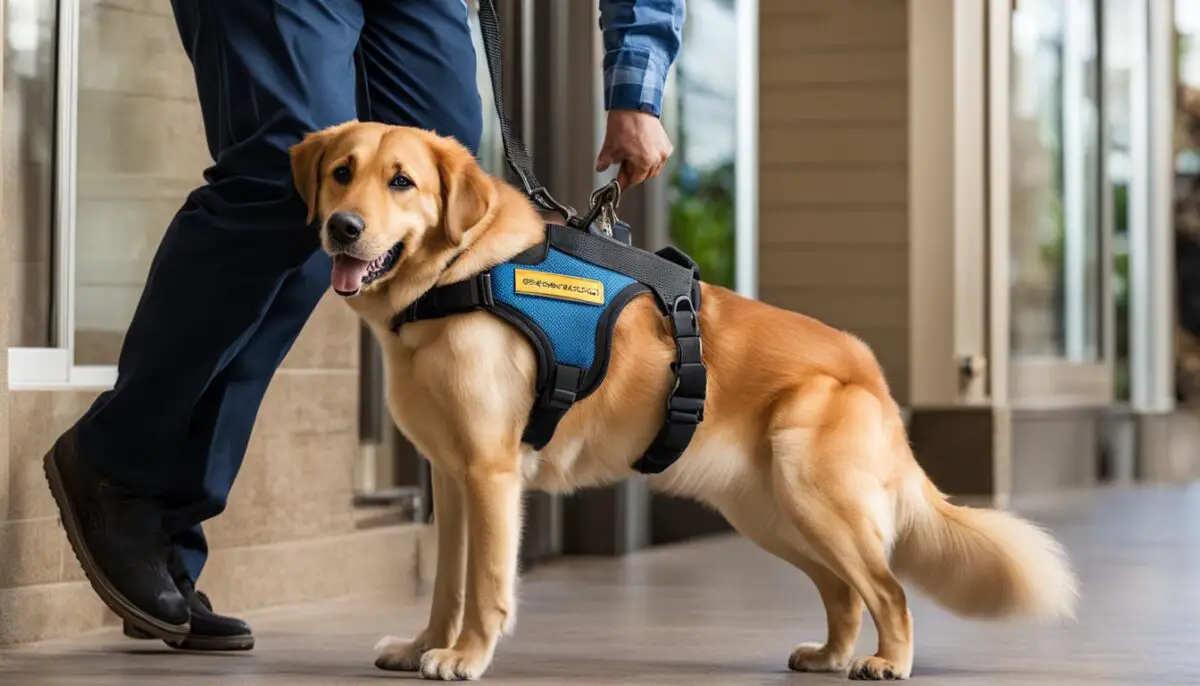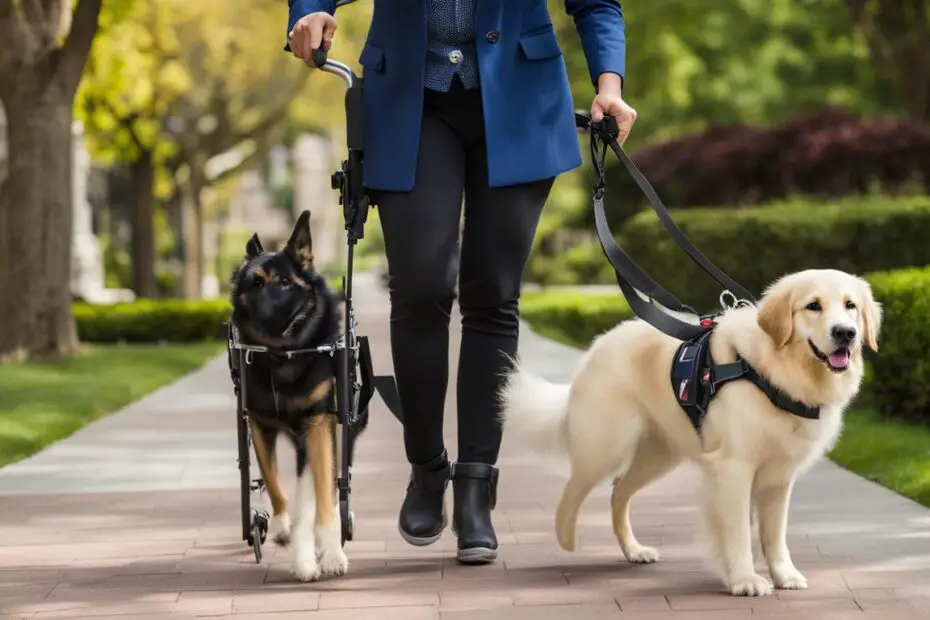Having a mobility service dog can make a world of difference for individuals with physical disabilities. These specially trained canines provide invaluable support and assistance, enabling their human partners to overcome mobility challenges and live more independent lives. In this comprehensive guide, we will explore the benefits of mobility service dogs, their training process, and how they can positively impact the lives of disabled individuals.
When it comes to mobility assistance, there’s nothing quite like a trained mobility service dog. These remarkable animals undergo rigorous training to meet the specific needs of their handlers. Whether it’s opening doors, retrieving objects, or providing stability through their harness, mobility service dogs excel at performing a variety of tasks that can greatly enhance the quality of life for individuals with mobility disabilities.
Key Takeaways
- Mobility service dogs provide support and assistance to individuals with physical disabilities.
- These dogs are trained to perform tasks such as opening doors and retrieving objects.
- Having a mobility service dog can greatly increase independence and improve overall quality of life.
- The training and certification process for mobility service dogs is rigorous.
- These dogs can benefit individuals with a wide range of mobility disabilities.
What is a Mobility Assistance Dog?
A mobility assistance dog, also known as a service dog, is a trained canine that provides invaluable support and assistance to individuals with disabilities. These specially trained dogs are the epitome of companionship and reliability, helping their human partners navigate through the challenges posed by mobility issues.
Designed to aid individuals with a range of disabilities, such as those who use wheelchairs or have balance and strength impairments, mobility assistance dogs are adept at performing various tasks that enhance their handlers’ independence. From opening doors and retrieving objects to providing stability through their harness, these dogs offer a myriad of practical benefits.
Every mobility assistance dog undergoes comprehensive and rigorous training to ensure they can meet the specific needs of their handlers. Their impressive range of capabilities enables them to provide reliable and independent assistance, alleviating the reliance of individuals with disabilities on others for daily tasks and ensuring a greater sense of independence.

Here are the key benefits provided by mobility assistance service dogs:
- Enhanced mobility and improved balance
- Assistance in daily activities and tasks
- Increased independence and self-reliance
- Emotional support and companionship
- Improved safety, especially during emergencies
- Greater confidence and improved overall well-being
These benefits, along with the outstanding capabilities of mobility service dogs, make them indispensable partners for individuals with mobility disabilities. The unconditional love and unwavering support provided by these devoted canines are truly life-changing.
Tasks Mobility Service Dogs Can Help With
Mobility service dogs are highly trained to perform a variety of tasks to assist individuals with mobility disabilities. These incredible canines provide essential support and assistance, enabling their handlers to navigate their daily lives with greater ease and independence.
Here are some of the key tasks that mobility service dogs can help with:
- Providing support and stability while walking or standing, ensuring their handlers’ safety and balance.
- Assisting with dressing and undressing by retrieving clothing items and helping their handlers with buttons, zippers, or fasteners.
- Retrieving objects such as keys, phones, or wallets, making it easier for their handlers to access essential items.
- Opening doors or operating light switches, allowing individuals with mobility disabilities to move freely within their environments.
- Carrying bags or small items, reducing the burden on their handlers and enabling them to navigate public spaces comfortably.
- Providing balance and support while going up and down stairs, ensuring their handlers’ safety and preventing falls.
A mobility service dog assisting their handler with walking and stability.
Each mobility service dog is carefully trained to meet the specific needs of their handler, catering to individual requirements and preferences. These tasks not only enhance the physical capabilities of individuals with mobility disabilities but also offer emotional support, companionship, and a greater sense of confidence and self-reliance.
Through their remarkable skills and unwavering dedication, these dogs play a crucial role in improving the overall well-being and quality of life for individuals with mobility disabilities.
Conclusion
Mobility service dogs are invaluable companions for individuals with mobility disabilities, providing both practical assistance and emotional support. These trained canines play a crucial role in improving the quality of life for their handlers, allowing them to gain greater independence and perform daily tasks with ease.
The benefits of having a mobility service dog are numerous. These dogs enhance mobility, enabling individuals to navigate their environment more easily. They also contribute to improved emotional well-being by providing companionship, reducing feelings of isolation, and increasing overall happiness and satisfaction.
The training and certification process for mobility service dogs is rigorous, ensuring that these canines are reliable and capable of performing their tasks. By undergoing specialized training, these dogs are equipped with the skills needed to assist their handlers effectively. Certification further ensures their competence and professionalism, giving individuals with mobility disabilities the confidence and assurance they need.
Overall, mobility service dogs significantly improve the lives of individuals with mobility disabilities. Whether it’s providing physical assistance or emotional support, these dogs have a profound impact on their handlers’ quality of life, promoting independence, self-reliance, and a stronger sense of confidence. With their unwavering loyalty and dedication, mobility service dogs truly make a difference in the lives of those in need.
FAQ
What is a mobility service dog?
A mobility service dog is a trained canine that provides support and assistance to individuals with physical disabilities. These dogs are specifically trained to perform various tasks to help their human partners with mobility issues.
How can a mobility service dog benefit someone with a disability?
Having a mobility service dog can greatly increase a person’s independence and improve their overall quality of life. These dogs undergo specialized training to meet the specific needs of their handlers and are certified to perform their tasks.
Who can benefit from a mobility assistance service dog?
Individuals with physical impairments, balance issues, and medical conditions that affect mobility can benefit from a mobility assistance service dog. These dogs can provide support, stability, and assistance when transitioning between positions, walking, and performing daily tasks.
What tasks can mobility service dogs help with?
Mobility service dogs can help with a wide range of tasks, including providing support and stability while walking, assisting with dressing and undressing, retrieving objects, opening doors, turning lights on and off, carrying bags, and providing balance while going up and down stairs.
How do mobility service dogs improve the quality of life for individuals with mobility disabilities?
Mobility service dogs play a crucial role in improving the quality of life for individuals with mobility disabilities. They provide assistance and support, allowing their handlers to gain greater independence and perform daily tasks with ease. The training and certification process for these dogs ensures that they are reliable and capable of performing their tasks.

